Geometry Homework Practice Workbook 1st Edition Chapter 2 Inductive Reasoning and Conjecture
Page 17 Problem 1 Answer
In the question, we have given the following statements:
p:−3−2=−5
q: Vertical angles are congruent.r:2+8>10
s: The sum of the measures of complementary angles is 90∘.
We have the task to write a compound statement for p and q conjunction or disjunction and find its truth value.
Here we can see that p and q:−3−2=−5 and vertical angles are congruent and we know that the vertical angles are always congruent.
So, the conjunction is true.
Hence our conjunction is true that p and q:−3−2=−5 and vertically opposite angles are congruent. from the given statements:
In the question, we have given the following statements:
p:−3−2=−5
q: Vertical angles are congruent.
r:2+8>10
s: The sum of the measures of complementary angles is 90.
Page 17 Problem 2 Answer
In the question, we have given the following statements:
p:−3−2=−5
q:Vertical angles are congruent.
r:2+8>10
s: The sum of the measures of complementary angles is 90∘.
We have to write a compound statement for p∨r conjunction or disjunction and find its truth value.
Here we can see that, it is false that r:2+8>10 as the correct is r:2+8=10.
So, the conjunction is false.
Hence the compound statement is false that p∨r:−3−2=−5 and 2+8>10.
As the truth value will be for r:2+8=10 from the given statement.
p:−3−2=−5
q: Vertical angles are congruent.
r:2+8>10
s: The sum of the measures of complementary angles is 90∘.
Page 17 Problem 3 Answer
In the question, we have given the following statements:
p:−3−2=−5
q: Vertical angles are congruent.
r:2+8>10
s: The sum of the measures of complementary angles is 90∘.
We have the task to write a compound statement for p or s conjunction or disjunction and find its truth value.
Here we have p or s:−3−2=−5 or the sum of the measures of complementary angles is 90∘.
Since both of them are true and we have given ‘or’ in between.
So, the statement is true.
Hence our conjunction is true that p or s:−3−2=−5 or the sum of the complementary angles is 90∘from the given statements: p:−3−2=−5
q: Vertical angles are congruent.
r:2=8>10
s: The sum of the measures of complementary angles is 90∘.
Page 17 Problem 4 Answer
In the question, we have given the following statements:
p:−3−2=−5
q: Vertical angles are congruent.
r:2+8>10
s: The sum of the measures of complementary angles is 90∘.
We have the task to write a compound statement for r∨s conjunction or disjunction and find its truth value.
Here we have r or s:2+8>10 or the sum of the measures of complementary angles is 90∘.
Since one of them is true and we have given ‘or’ in between.
So, we conclude that the statement is true.
Hence we conclude that our conjunction is true that r or s:2+8>10 or the sum of the complementary angles is from the given statements:
p:−3−2=−5
q:Vertical angles are congruent.
r:2+8>10
s: The sum of the measures of complementary angles is 90∘.
Page 17 Problem 5 Answer
In the question, we have given the following statements:
p:−3−2=−5
q: Vertical angles are congruent.
r:2+8>10
s: The sum of the measures of complementary angles is 90∘.
We have to write a compound statement for p∧∼q conjunction or disjunction and find its truth value.
From the given ∼q: vertical angles are not congruent.
Now we have p∧∼q:−3−2=−5
and vertical angles are not congruent.
Since one of them is false and we have given ‘∧ implies and’ in between.
So, we conclude that the statement is false.
Hence we conclude that our conjunction is false that p∧∼q:−3−2=−5 and vertical angles are not congruent, from the given statements:
p:−3−2=−5
q: Vertical angles are congruent.
r:2+8>10
s: The sum of the measures of complementary angles is 90∘.
Page 17 Problem 6 Answer
In the question, we have given the following statements:
p:−3−2=−5
q: Vertical angles are congruent.
r:2+8>10
s: The sum of the measures of complementary angles is 90∘.
We have to write a compound statement for q∨∼r conjunction or disjunction and find its truth value.
From the given ∼r:2+8≤10.
Now Here we have q∨∼r: the sum of the measures of complementary angles is 90∘ or 2+8≤10 Since both of them are true and we have given ‘∧ implies or’ in between.
So, we conclude that the statement is true.
Hence we conclude that our conjunction is true that q∨∼r: the sum of the complementary angles is 90∘ or 2+8≤10 from the given statements:
p:−3−2=−5
q: Vertical angles are congruent.
r:2+8>10
s: The sum of the measures of complementary angles is 90∘.
Page 17 Problem 7 Answer
We have been given a truth table that is,
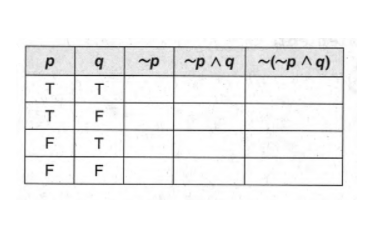
We have to complete it.
We will complete it by knowing the truth values of logical expressions.
Let us complete the truth table that is,

Hence, we have completed the given truth table that is,

Page 17 Problem 8 Answer
We have been given a truth table that is,
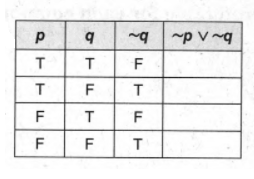
We have to complete it.
We will complete it by knowing the truth values of logical expressions.
Let us complete the truth table that is,

Hence, we have completed the given truth table that is,
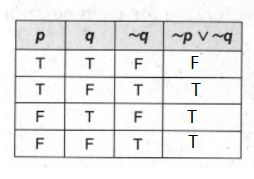
Page 17 Problem 9 Answer
In this question, we have been given the value:∼q∧r
We need to construct a truth table for the compound statement.
By using Inductive Reasoning and Conjecture, we will calculate the result.
We construct a truth table for the given compound statement
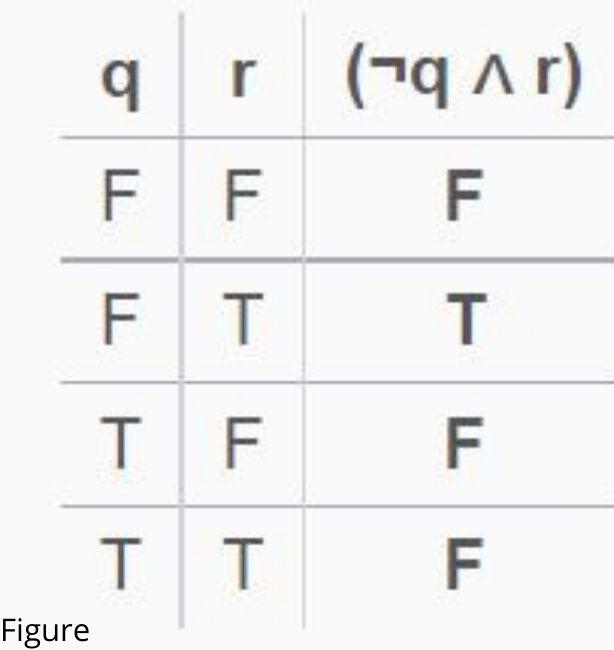
Hence, a graph with rows and columns shows how the truth or falsity of a claim fluctuates depending on the truth or falsity of its constituents.
We construct a truth table for the given compound statement ∼q∧r is

Page 17 Problem 10 Answer
In this question, we have been given the value: ∼p∨∼r
We need to construct a truth table for the compound statement.
By using Inductive Reasoning and Conjecture, we will calculate the result.
We construct a truth table for the given compound statement
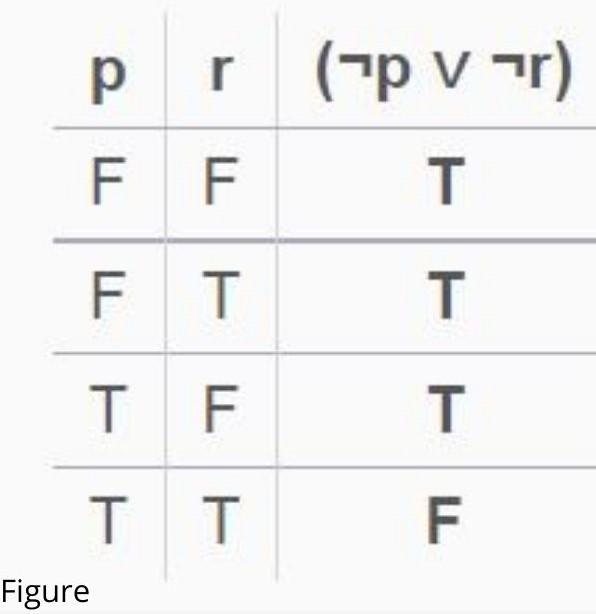
Hence, a graph with rows and columns shows how the truth or falsity of a claim fluctuates depending on the truth or falsity of its constituents.
We construct a truth table for the given compound statement ∼p∨∼r is
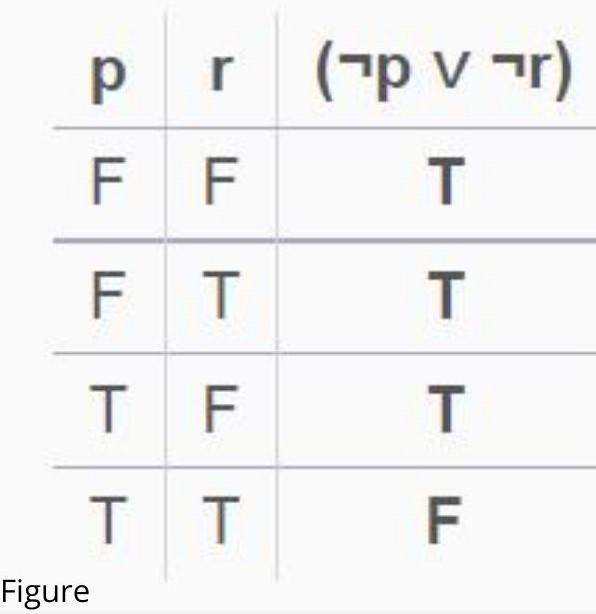
Page 18 Problem 11 Answer
We have been given the following statements that are,p: 60 seconds = 1-minute q: Congruent supplementary angles each have a measure of 90.
r:−12+11<−1
We have to write a disjunction statement for q∨r.
Therefore, the disjunction statement for q∨r is, ” congruent supplementary angles each have a measure of 90 or −12+11<−1″.
We see that the first statement is true and the second statement is false.
Since one of the statements in the disjunction is true, then the disjunction is also true.
Hence, we have written a disjunction statement for q∨r that is, ” congruent supplementary angles each have a measure of 90 or −12+11<−1″ and found that the truth value of the disjunction is true.
Page 18 Problem 12 Answer
We have been given the following statements that are,p: 60 seconds = 1-minute q: Congruent supplementary angles each have a measure of 90.
r.−12+11<−1 We have to write a conjunction statement for ∼p∨q.
First, we will find the negation of p that is,∼p”60 seconds≠1 minute”.
Therefore, the conjunction statement for ∼p∨q is,” 60 seconds≠1 minute and Congruent supplementary angles each have a measure of 90″.
We see that the first statement is false and the second statement is true.
Since one of the statements in the conjunction is false, then the truth value of the conjunction is false,
Hence, we have written a disjunction statement for ∼p∨q that is, “60 seconds≠1 minute and Congruent supplementary angles each have a measure of 90 “and found that the truth value of the conjunction statement is false.
Page 18 Problem 13 Answer
We have been given the following statements that are,p: 60 seconds = 1 minute q: Congruent supplementary angles each have a measure of 90.
r :−12+11<−1
We have to write a disjunction statement for ∼p∧∼r.
First, we will find the negation of p and r that is,∼p: 60 seconds≠1minute.
∼r:−12+11≮−1.
Therefore, the disjunction statement for ∼p∧∼r that is,” 60 seconds≠1 minute or −12+11≮−1.
We see that the first statement is false and the second statement is true.
Since one of the statements of the disjunction is true, then the truth value of the disjunction is true.
Hence, we have written a disjunction statement for ∼p∧∼r that is,” 60 seconds≠1 minute or −12+11≮−1″ and found that the truth value of the disjunction is true.
Page 18 Problem 14 Answer
We have been given a truth table that is,
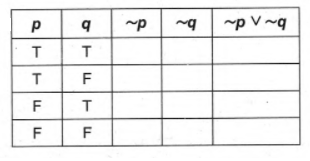
We have to complete it.
We will complete it by knowing the truth values of logical expressions.
Let us complete the truth table that is,

Hence, we have completed the given truth table that is,

Page 18 Problem 15 Answer
We have been given a truth table that is,
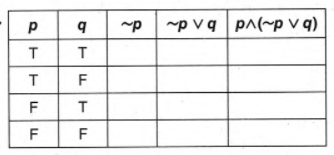
We have to complete it.
We will complete it by knowing the truth values of logical expressions.
Let us complete the truth table that is,
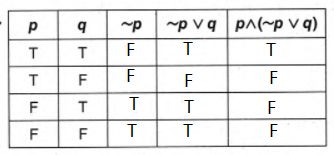
Hence, we have completed the given truth table that is,
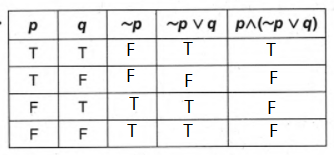
Page 18 Problem 16 Answer
We are given a compound statement q∨(p∧∼q).
We are required to construct a truth table for it.
Here, we will break the compound statement to its constituent simple statements and then find the truth or falsity of each to combine and get the table.
Breaking the given compound to simple statements and evaluating whether it is true or false, we get the truth table,
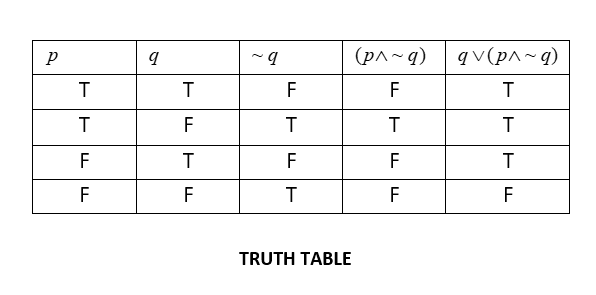
We get the truth table for q∨(p∧∼q) as,
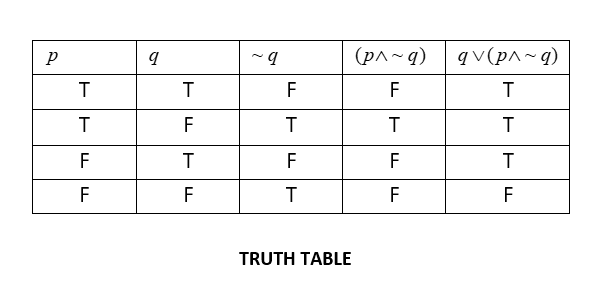
Page 18 Problem 17 Answer
We are given a compound statement ∼q∧(∼p∨q).
We are required to construct a truth table for it.
Here, we will break the compound statement to its constituent simple statements and then find the truth or falsity of each to combine and get the table.
We know that,
∼q∧(∼p∨q)=∼[q∨(p∧∼q)]
Hence, we get,
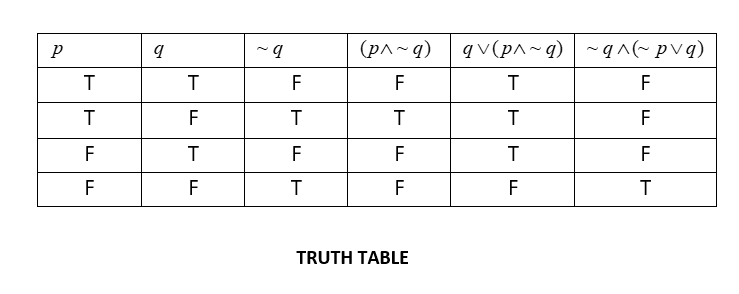
We get the truth table for the compound statement ∼q∧(∼p∨q) as,

Page 18 Problem 18 Answer
We are given a Venn diagram that shows the number of students in the band who work after school or on the weekends.
We are required to find the number of students that work after school and on weekends.
We can see that from the Venn diagram, the intersection of the two given circles represent the number of students that work after school and on weekends and has the value 3.
Hence, the number of students that work after school and on weekends=3.
From the Venn diagram, we have, The number of students that work after school and on weekends=3
Page 18 Problem 19 Answer
We are given a Venn diagram that shows the number of students in the band who work after school or on the weekends.
We are required to find the number of students that work after school or on weekends.
Here, we can see that the Venn diagram shows the number of students in the band who work after school or on the weekends, and hence, the required problem asks us to find the union of both the circles in the diagram.
We get the union of the two circles given in the Venn diagram as, the number of students that work after school or weekends=5+3+17=25
From the Venn diagram we have, the number of students that work after school or weekends=25
